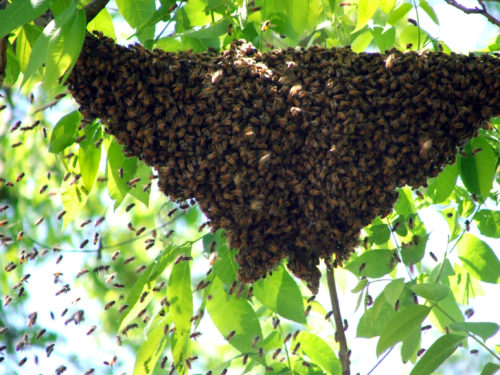 Purdue University - Extension - Forestry and Natural Resources
Purdue University - Extension - Forestry and Natural Resources
Got Nature? Blog
 The idea of 10,000 honey bees swarming is a very, very unsettling thought for many people. This sounds like a dangerous and maybe even deadly situation, but in reality, it usually isn’t. Large swarms of honey bees are actually fairly common and completely harmless unless provoked.
The idea of 10,000 honey bees swarming is a very, very unsettling thought for many people. This sounds like a dangerous and maybe even deadly situation, but in reality, it usually isn’t. Large swarms of honey bees are actually fairly common and completely harmless unless provoked.
As a colony of honey bees grows, sooner or later it outgrows its hive, and it is time to spread out and create a new one. This process starts with the production of new queens. They are grown in special chambers and are fed a diet of “royal jelly” as they grow. When the first one emerges from its chamber fully developed, it kills the others to eliminate the competition.
This new queen leaves the hive in search of “drone zones,” areas where male honey bee drones congregate in hopes to mate with the queen. After a successful mating, the queen returns to the hive, signaling the worker bees of the colony to begin preparing for swarming. Some fly from the hive to explore and search for possible new locations for a new hive. Meanwhile, others start reducing the old queen’s diet, slimming her down in preparation for the swarming. When the new queen begins laying eggs, it is officially time to swarm.
The older bees escort the old queen out of the hive in a massive swarm towards the location scouted out previously to begin a new colony. However, sometimes when a suitable location hasn’t been found in time, the swarm lands on the ground, protecting the queen in the center until one can be found. While probably terrifying to someone with a fear of bees, there is no reason to be alarmed. These bees are focused on protecting the queen and won’t leave the cluster or sting anyone unless provoked. Eventually, when a location is found, the cluster swarms to it and starts a new colony.
So if you encounter a huge group of honey bees, don’t panic. While they might look intimidating, these bees are busy transitioning to a new colony and don’t pose a hazard to anyone.
Resources
Swarms Hanging Around, Purdue Extension
On Six Legs Podcast, Purdue Extension
Indiana Honey Bee Swarms, Indiana Department of Natural Resources
The Education Store, Purdue Extension Resource Center
Tom Turpin, Professor, Insect Outreach, Instruction Development Specialist
Department of Entomology, Purdue University

Recent Posts
- Publication – Introduction to White-tailed Deer Impacts on Indiana Woodlands
Posted: April 28, 2024 in Forestry, Land Use, Plants, Publication, Wildlife, Woodlands - Publication – Understanding White-tailed Deer and Their Impact on Indiana Woodlands
Posted: in Forestry, Land Use, Plants, Publication, Wildlife, Woodlands - Publication – Monitoring White-tailed Deer and Their Impact on Indiana Woodlands
Posted: in Forestry, Land Use, Plants, Publication, Wildlife, Woodlands - Publication – Managing White-tailed Deer Impacts on Indiana Woodlands
Posted: in Forestry, Land Use, Plants, Publication, Wildlife, Woodlands - Report Spotted Lanternfly – Purdue Landscape Report
Posted: April 10, 2024 in Alert, Forestry, Invasive Insects, Plants, Wildlife, Woodlands - Declining Pines of the White Variety – Purdue Landscape Report
Posted: in Alert, Disease, Forestry, Plants, Wildlife, Woodlands - Are you seeing nests of our state endangered swan? – Wild Bulletin
Posted: April 9, 2024 in Alert, Forestry, How To, Wildlife - Cicadas in Spring! – Purdue Landscape Report
Posted: in Forestry, Plants, Safety, Wildlife - New Deer Impact Toolbox
Posted: April 7, 2024 in Forestry, Land Use, Plants, Publication, Safety, Wildlife, Woodlands - 2024-25 Fishing Guide now available – Wild Bulletin
Posted: April 4, 2024 in Alert, Aquaculture/Fish, Aquatic/Aquaculture Resources, How To, Ponds, Wildlife
Archives
Categories
- Alert
- Aquaculture/Fish
- Aquatic/Aquaculture Resources
- Ask the Expert
- Christmas Trees
- Community Development
- Disease
- Drought
- Forestry
- Forests and Street Trees
- Gardening
- Got Nature for Kids
- Great Lakes
- How To
- Invasive Animal Species
- Invasive Insects
- Invasive Plant Species
- Land Use
- Natural Resource Planning
- Nature of Teaching
- Plants
- Podcasts
- Ponds
- Publication
- Safety
- Timber Marketing
- Uncategorized
- Urban Forestry
- Webinar
- Wildlife
- Wood Products/Manufacturing
- Woodland Management Moment
- Woodlands